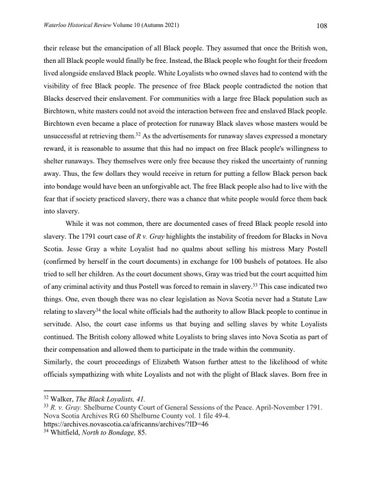Waterloo Historical Review Volume 10 (Autumn 2021)
108
their release but the emancipation of all Black people. They assumed that once the British won, then all Black people would finally be free. Instead, the Black people who fought for their freedom lived alongside enslaved Black people. White Loyalists who owned slaves had to contend with the visibility of free Black people. The presence of free Black people contradicted the notion that Blacks deserved their enslavement. For communities with a large free Black population such as Birchtown, white masters could not avoid the interaction between free and enslaved Black people. Birchtown even became a place of protection for runaway Black slaves whose masters would be unsuccessful at retrieving them.32 As the advertisements for runaway slaves expressed a monetary reward, it is reasonable to assume that this had no impact on free Black people's willingness to shelter runaways. They themselves were only free because they risked the uncertainty of running away. Thus, the few dollars they would receive in return for putting a fellow Black person back into bondage would have been an unforgivable act. The free Black people also had to live with the fear that if society practiced slavery, there was a chance that white people would force them back into slavery. While it was not common, there are documented cases of freed Black people resold into slavery. The 1791 court case of R v. Gray highlights the instability of freedom for Blacks in Nova Scotia. Jesse Gray a white Loyalist had no qualms about selling his mistress Mary Postell (confirmed by herself in the court documents) in exchange for 100 bushels of potatoes. He also tried to sell her children. As the court document shows, Gray was tried but the court acquitted him of any criminal activity and thus Postell was forced to remain in slavery.33 This case indicated two things. One, even though there was no clear legislation as Nova Scotia never had a Statute Law relating to slavery34 the local white officials had the authority to allow Black people to continue in servitude. Also, the court case informs us that buying and selling slaves by white Loyalists continued. The British colony allowed white Loyalists to bring slaves into Nova Scotia as part of their compensation and allowed them to participate in the trade within the community. Similarly, the court proceedings of Elizabeth Watson further attest to the likelihood of white officials sympathizing with white Loyalists and not with the plight of Black slaves. Born free in 32
Walker, The Black Loyalists, 41. R. v. Gray. Shelburne County Court of General Sessions of the Peace. April-November 1791. Nova Scotia Archives RG 60 Shelburne County vol. 1 file 49-4. https://archives.novascotia.ca/africanns/archives/?ID=46 34 Whitfield, North to Bondage, 85. 33

